Understanding Types of Agents in Artificial Intelligence: A Detailed Comparison
In the realm of Artificial Intelligence (AI), agents are systems or entities capable of perceiving their environment and taking actions to achieve specific goals. Different types of agents are used based on their capabilities, complexity, and the problems they are designed to solve. These agents vary in their level of sophistication, from simple reflex-based systems to advanced learning and utility-driven agents. In this blog post, we’ll explore Simple Reflex Agents, Model-Based Reflex Agents, Goal-Based Agents, Utility-Based Agents, and Learning Agents in detail.
1. Simple Reflex Agents
What Are They?
Simple Reflex Agents are the most basic type of agents in AI. These agents operate based on a set of predefined rules or conditions that map percepts (input from the environment) directly to actions. They do not consider the history of percepts or any internal model of the world.
How They Work:
- Simple reflex agents respond directly to their current environment without any reasoning about the past or future.
- They follow a condition-action rule: “If a certain condition is true, then perform the corresponding action.”
- They only act based on the current percept, ignoring any other factors like past actions or future consequences.
Example:
A thermostat can be considered a simple reflex agent. It measures the temperature and, based on a predefined threshold (e.g., if temperature > 25°C), it turns on the air conditioner. It does not “remember” what the previous temperature was or “predict” future temperature changes.
Limitations:
- No Memory: They don’t have the ability to store previous states or learn from them.
- Limited Environment Handling: Simple reflex agents are only effective in fully observable and straightforward environments. If the environment becomes more complex or partially observable, they may fail to act optimally.
2. Model-Based Reflex Agents
What Are They?
Model-Based Reflex Agents build on the concept of simple reflex agents but are slightly more advanced because they maintain an internal model of the world. This internal model allows them to keep track of parts of the environment that are not immediately observable.
How They Work:
- These agents use the current percept and their internal state (a model of how the world works) to make decisions.
- The internal state helps the agent remember information about the parts of the environment that are not currently visible.
- The agent’s decision-making process is still based on a set of rules (condition-action), but the internal model provides a deeper understanding of how actions impact the environment.
Example:
Consider a robotic vacuum cleaner (like a Roomba) that uses sensors to detect obstacles. It builds a model of the environment as it navigates, remembering where obstacles are located and using that information to avoid collisions in future movements.
Advantages:
- Partial Observability: They are better suited for environments where not all information is directly observable at any given time.
- Internal State: By maintaining a model of the world, these agents can handle more complex environments than simple reflex agents.
Limitations:
- Still Reactive: Although model-based reflex agents use an internal model, they are still fundamentally reactive. They lack the ability to plan or consider long-term goals.
3. Goal-Based Agents
What Are They?
Goal-Based Agents go beyond simple reactions by considering future outcomes in their decision-making process. These agents are designed to achieve specific goals, meaning they are capable of planning and taking actions that bring them closer to their objectives.
How They Work:
- Goal-based agents are not limited to predefined rules. They take into account goals or desired outcomes that guide their actions.
- They often use search and planning algorithms to find sequences of actions that will lead them to the goal.
- The agent compares its current state to the desired goal and decides on the actions that will help achieve the goal.
Example:
A chess-playing AI is a goal-based agent. Its goal is to checkmate the opponent, and it calculates sequences of moves that bring it closer to this goal. It can look ahead to predict potential moves and counter-moves, choosing the ones that align best with its goal.
Advantages:
- Flexibility: Goal-based agents can change their behavior dynamically depending on the desired goal.
- Long-Term Planning: They are capable of planning a series of actions, rather than just reacting to the immediate environment.
Limitations:
- Requires Accurate Goals: These agents rely heavily on the formulation of clear and achievable goals.
- Computational Complexity: Planning and goal-seeking can be computationally expensive, especially in complex environments.
4. Utility-Based Agents
What Are They?
Utility-Based Agents enhance goal-based agents by introducing the concept of utility or preference for different states. Instead of just achieving a goal, these agents strive to maximize their performance or the overall “happiness” with the outcome.
How They Work:
- Utility-based agents assign a utility value to different states or outcomes. The utility is a numerical representation of how desirable or useful a particular state is to the agent.
- The agent not only considers which actions will help achieve a goal but also evaluates the quality of those actions in terms of maximizing overall utility.
- They weigh different possible outcomes and choose actions that maximize expected utility, even if those actions may not directly achieve the goal in the short term.
Example:
A self-driving car is a utility-based agent. It evaluates multiple routes to reach its destination, not just based on the shortest distance but also considering factors like traffic, safety, and fuel efficiency to maximize utility.
Advantages:
- Optimal Decision-Making: These agents can make trade-offs and choose the best actions based on a variety of factors.
- Handling Uncertainty: They are often capable of dealing with uncertain environments by considering the expected utility of actions under various circumstances.
Limitations:
- Complexity: Calculating utility and making decisions in uncertain environments can be resource-intensive.
- Utility Definition: Defining the utility function accurately for all possible situations can be challenging.
5. Learning Agents
What Are They?
Learning Agents are the most advanced type of agent. They have the ability to learn from experience and improve their performance over time. Unlike other agents that rely on predefined rules or models, learning agents can adapt to changing environments and learn new behaviors.
How They Work:
- Learning agents have four main components: a performance element (which selects actions), a learning element (which improves the performance), a critic (which provides feedback on actions), and a problem generator (which suggests new experiences to learn from).
- These agents start with limited knowledge but improve by interacting with the environment. Over time, they can learn which actions lead to better results.
- Learning can be based on various techniques, such as reinforcement learning, supervised learning, or unsupervised learning.
Example:
A personal assistant AI (e.g., Google Assistant or Siri) is a learning agent. It learns from user interactions, improving its ability to understand and predict user preferences over time.
Advantages:
- Adaptability: Learning agents can adapt to new environments and improve their performance over time.
- Long-Term Efficiency: As they learn, they become more efficient at achieving their goals or maximizing utility.
Limitations:
- Training Requirements: Learning agents may require a lot of data or time to train and improve.
- Potential for Error: During the learning process, they can make mistakes or suboptimal decisions.
Expanding on AI Agent Types: From Basics to Advanced Concepts
To deepen the understanding of agent types in Artificial Intelligence, let’s explore additional aspects, moving from fundamental principles to more advanced topics. Here, we’ll cover further distinctions, subtypes, and considerations, providing a more comprehensive view of agent design and functionality.
1. Reactive vs Deliberative Agents
Reactive Agents
- Definition: Reactive agents act purely based on the present situation. These agents don’t plan or predict; they make decisions solely on the current percept (input).
- Characteristics: They operate in real-time, exhibit low latency, and are typically implemented using simple rules.
- Real-World Example: A fire alarm system, which reacts instantly when it detects smoke or heat without analyzing any other parameters.
Deliberative Agents
- Definition: These agents use an internal world model to plan their actions by simulating future states. They “deliberate” on actions by considering multiple possibilities before making a decision.
- Characteristics: Deliberative agents employ planning, reasoning, and decision-making, allowing them to act in more complex environments.
- Real-World Example: Autonomous drones that plan flight paths by considering wind conditions, obstacles, and battery levels to achieve their objectives.
Comparison:
- Efficiency: Reactive agents are typically faster but less flexible, while deliberative agents are slower but can handle complex tasks requiring foresight.
2. Single-Agent Systems vs Multi-Agent Systems (MAS)
Single-Agent Systems
- Definition: A single-agent system involves just one agent interacting with the environment to achieve its objectives.
- Application: Simple tasks like automated vacuuming, where one agent needs to clean an area.
Multi-Agent Systems (MAS)
- Definition: In a MAS, multiple agents work in a shared environment, either cooperating or competing to achieve goals.
- Key Considerations:
- Cooperative MAS: Agents share information and work towards common goals (e.g., swarm robotics, where multiple drones work together to perform a task).
- Competitive MAS: Agents compete for resources or outcomes (e.g., AI in real-time strategy games or financial markets).
Advanced Topics in MAS:
- Coordination: How agents share tasks and coordinate actions.
- Communication: The protocols and languages used by agents to communicate with each other.
- Conflict Resolution: Methods to manage and resolve conflicts between competing agents in MAS.
3. Knowledge-Based Agents
Definition:
Knowledge-based agents use symbolic reasoning and a knowledge base (KB) to make decisions. They store information in a structured form (e.g., facts, rules) and use it to infer new knowledge and make decisions.
How They Work:
- These agents have a knowledge base that contains facts about the world.
- They use logical reasoning methods (like propositional logic or first-order logic) to infer conclusions and make decisions.
Knowledge Representation:
- Declarative Knowledge: Facts about the world that can be directly stated (e.g., “The sky is blue”).
- Procedural Knowledge: Information about how to perform tasks (e.g., the steps required to solve a math problem).
Advantages:
- Flexibility in reasoning and decision-making.
- Ability to deal with complex, real-world environments through structured knowledge.
Limitations:
- High computational requirements for reasoning.
- Knowledge acquisition bottleneck (getting structured knowledge into the system can be difficult).
4. BDI Agents (Belief-Desire-Intention)
Definition:
BDI agents are based on the Belief-Desire-Intention model, which is a framework for modeling rational agents. These agents make decisions based on three core components:
- Beliefs: What the agent believes about the world.
- Desires: The goals or objectives the agent wishes to achieve.
- Intentions: The actions the agent has committed to taking to achieve its desires.
Key Concepts:
- Belief Revision: Updating beliefs based on new information from the environment.
- Desire Management: Handling conflicting goals or desires.
- Intention Commitment: Once an agent commits to a set of actions, it follows through unless it’s no longer feasible.
Application:
BDI agents are used in real-time strategy games, autonomous systems, and interactive simulations, where decision-making involves managing multiple objectives and updating beliefs in real-time.
5. Adaptive Agents
Definition:
Adaptive agents can adjust their behavior in response to changes in the environment or their internal state. This adaptability allows them to improve performance or cope with novel situations.
Types of Adaptations:
- Rule Adaptation: Modifying the decision-making rules based on experiences.
- Behavioral Adaptation: Learning new actions or behaviors when the environment changes.
Example:
A stock trading bot that adjusts its trading strategy based on recent market trends is an adaptive agent. It analyzes historical data and changes its decision-making process dynamically to maximize profits.
Techniques for Adaptation:
- Reinforcement Learning: Agents learn to adapt by maximizing rewards from interactions with the environment.
- Evolutionary Algorithms: Agents evolve over time, mutating and selecting the best-performing behaviors.
6. Collaborative Filtering and Recommendation Agents
Definition:
Collaborative filtering agents recommend items (such as movies, products, or music) to users based on their preferences and the preferences of other users with similar tastes.
Types of Collaborative Filtering:
- User-Based Filtering: Recommends items based on the preferences of similar users.
- Item-Based Filtering: Recommends items similar to those the user has liked in the past.
Real-World Example:
Recommendation systems in e-commerce (like Amazon) or streaming services (like Netflix) use collaborative filtering to suggest products or content based on users’ preferences and historical data.
7. Social Agents
Definition:
Social agents are designed to interact and collaborate with humans or other agents in a social context. They must understand social norms, communication cues, and collaboration protocols.
Features of Social Agents:
- Communication: Ability to understand and generate human language or symbolic communication.
- Negotiation: Ability to negotiate with other agents or humans to reach mutually beneficial outcomes.
- Emotion Recognition and Response: In more advanced systems, social agents can recognize human emotions and respond appropriately (e.g., virtual assistants or customer service bots).
Examples:
- Chatbots and Virtual Assistants: Like Alexa or Siri, which interact with humans in natural language.
- Interactive Robots: Robots designed to interact socially with people in contexts such as healthcare, companionship, or customer service.
8. Cognitive Agents
Definition:
Cognitive agents are designed to simulate human-like thinking processes, using models of cognition to reason, plan, and act. They use architectures like SOAR or ACT-R to replicate aspects of human intelligence, such as memory, perception, and problem-solving.
Cognitive Architectures:
- SOAR (State, Operator, and Result): A cognitive architecture that models how agents can use knowledge and reasoning to select actions based on goals.
- ACT-R (Adaptive Control of Thought-Rational): Focuses on simulating human thought processes, including memory, decision-making, and learning.
Application:
Cognitive agents are used in virtual training environments, simulations, and advanced human-computer interaction systems, where the goal is to model and replicate complex decision-making and thought processes.
9. Emotion-Based Agents
Definition:
Emotion-based agents are designed to simulate emotions or respond to emotional stimuli from their environment. These agents can modify their behavior based on emotional states, either their own or the emotional cues of others.
How They Work:
- Emotion-based agents have a set of internal emotional states (like happiness, frustration, or excitement), which are influenced by their interactions with the environment or other agents.
- These emotional states affect their decision-making processes, leading to more human-like interactions.
Application:
Emotion-based agents are often used in interactive storytelling, customer service bots, and social robots where empathy or human-like interactions are important for user engagement.
10. Autonomous Agents vs Semi-Autonomous Agents
Autonomous Agents:
- Definition: Fully autonomous agents operate without human intervention, making all decisions based on their percepts and knowledge of the environment.
- Example: Autonomous drones or self-driving cars.
Semi-Autonomous Agents:
- Definition: Semi-autonomous agents can operate independently but require occasional human input or oversight.
- Example: Robotic systems in industrial settings that perform tasks but may need human input for complex decisions or emergency overrides.
Conclusion: A Spectrum of Intelligence
AI agents, from basic simple reflex agents to learning and cognitive agents, represent a vast spectrum of intelligence and functionality. As agents become more advanced, they transition from simple, rule-based systems to highly sophisticated models capable of reasoning, planning, learning, and interacting with the world in increasingly human-like ways.
The choice of agent depends on the complexity of the environment, the goals of the system, and the required level of intelligence, adaptability, and interaction. As AI continues to evolve, the capabilities of agents will further expand, leading to even more autonomous, intelligent, and adaptive systems in various applications.
The evolution from Simple Reflex Agents to Learning Agents illustrates the increasing complexity and intelligence of AI systems. Each type of agent has its strengths and limitations:
- Simple Reflex Agents are fast and straightforward but limited to fully observable environments.
- Model-Based Reflex Agents add memory, making them suitable for partially observable environments.
- Goal-Based Agents introduce planning and long-term thinking, focusing on achieving specific objectives.
- Utility-Based Agents bring in the concept of utility, allowing for optimal decision-making in complex situations.
- Learning Agents are the pinnacle of adaptability, continuously improving their performance through experience.
Each type of agent is designed for different use cases, and the choice of which to use depends on the complexity of the task and environment. As AI continues to evolve, agents will become increasingly sophisticated, leading to more intelligent systems that can autonomously make decisions, learn, and interact with the world around them.







